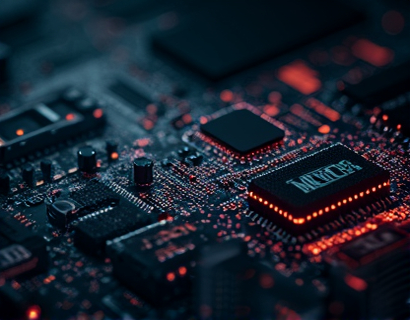Unlocking Blockchain Potential: Mastering Scalability and Security with Advanced Layer 2 Solutions for EVM-Enabled Development
In the rapidly evolving landscape of blockchain technology, the Ethereum Virtual Machine (EVM) has played a pivotal role in enabling the creation of decentralized applications (dApps). However, as the adoption of blockchain solutions grows, the limitations of the EVM, particularly in terms of scalability and security, have become increasingly apparent. To address these challenges, advanced Layer 2 (L2) solutions have emerged, offering innovative ways to enhance the performance and robustness of EVM-enabled development. This article delves into the intricacies of these L2 solutions, exploring how they can unlock the full potential of blockchain technology for developers.
Understanding the Challenges of EVM Scalability
The EVM, while powerful, faces significant scalability issues due to its design. Each transaction on the Ethereum network requires a new block, and the block time is set to approximately every 12-15 seconds. This limitation results in a maximum transaction throughput of around 15 transactions per second (TPS), which is far below the demands of modern applications. As the number of users and dApps grows, the network congestion leads to higher gas fees and longer confirmation times, deterring potential users and developers. These challenges necessitate the exploration of Layer 2 solutions that can offload some of the processing burden from the main chain.
What Are Layer 2 Solutions?
Layer 2 solutions refer to technologies built on top of the primary blockchain (Layer 1) to improve scalability, reduce costs, and enhance security without altering the underlying protocol. These solutions process transactions off the main chain, aggregating them into a single transaction that is then submitted to the EVM. This approach significantly reduces the load on the main chain, allowing for faster and cheaper transactions. Key L2 solutions include state channels, sidechains, and rollups, each with its unique mechanisms and benefits.
State Channels
State channels are a type of L2 solution that allows multiple parties to conduct a series of transactions off the main blockchain. These transactions are only recorded on the main chain once the channel is closed. This method is particularly useful for applications requiring frequent and small transactions, such as gaming or micropayments. By moving the bulk of the transaction processing off the main chain, state channels can achieve near-instant transaction times and minimal fees. However, they require all parties to be online simultaneously, which can be a limitation in certain use cases.
Sidechains
Sidechains are independent blockchains that are linked to the main chain through a two-way peg. They allow assets to be transferred between the main chain and the sidechain, enabling more flexible and scalable transaction processing. Sidechains can customize their consensus mechanisms and features, providing greater control over scalability and security. This flexibility makes sidechains suitable for a wide range of applications, from payment systems to complex dApps. However, the security of sidechains depends on the robustness of the peg mechanism and the underlying sidechain protocol.
Rollups
Rollups are one of the most promising L2 solutions for Ethereum, offering high scalability and security while maintaining interoperability with the main chain. There are two main types of rollups: Optimistic Rollups and ZK Rollups.
Optimistic Rollups bundle multiple transactions into a single transaction on the main chain, assuming all transactions are valid. If any transaction is found to be invalid, the rollup operator must prove it within a grace period. This approach significantly reduces the main chain's workload, allowing for thousands of transactions per second. However, the grace period can introduce some latency, and the security relies on the honesty of the rollup operator.
ZK Rollups, on the other hand, use zero-knowledge proofs to bundle and verify transactions off-chain, submitting a compact proof to the main chain. This method ensures instant finality and higher security, as the proof can be verified without revealing the transaction details. ZK Rollups offer the best of both worlds: high throughput and strong security guarantees. However, the complexity of zero-knowledge proofs can lead to higher gas costs and longer transaction times compared to Optimistic Rollups.
Enhancing Security with Layer 2 Solutions
Security is a paramount concern in blockchain development, and Layer 2 solutions offer several mechanisms to bolster the security of EVM-enabled applications. By offloading transaction processing to L2 layers, the main chain can focus on critical security functions, reducing the risk of attacks and vulnerabilities. Additionally, L2 solutions can implement advanced cryptographic techniques and consensus mechanisms to ensure the integrity and reliability of off-chain transactions.
For instance, ZK Rollups utilize zero-knowledge proofs to provide strong security guarantees without compromising on scalability. These proofs allow the main chain to verify the correctness of off-chain transactions without exposing sensitive data, maintaining privacy and security. State channels and sidechains also employ robust cryptographic protocols to secure transactions and prevent fraudulent activities. By distributing the computational load and leveraging advanced security features, L2 solutions create a more resilient and secure blockchain ecosystem.
Cost Efficiency in EVM-Enabled Development
One of the most significant advantages of Layer 2 solutions is their ability to reduce transaction costs. On the Ethereum main chain, gas fees can become exorbitant during periods of high network activity, making it challenging for developers to create cost-effective dApps. L2 solutions mitigate this issue by processing transactions off the main chain, where gas fees are either negligible or nonexistent. This cost efficiency is crucial for the widespread adoption of blockchain technology, especially for applications that require a high volume of transactions, such as decentralized finance (DeFi) and non-fungible tokens (NFTs).
Moreover, the reduced computational requirements of L2 solutions lower the barrier to entry for developers. With lower costs, more developers can experiment with and build innovative dApps without the financial burden of high gas fees. This democratization of blockchain development fosters a more vibrant and diverse ecosystem, driving further innovation and adoption.
Case Studies: Real-World Applications of Layer 2 Solutions
Several real-world applications demonstrate the effectiveness of Layer 2 solutions in enhancing scalability and security. For example, Optimism, a popular Optimistic Rollup solution, has successfully scaled numerous dApps, including decentralized exchanges and gaming platforms. Users have experienced faster transaction times and lower fees, leading to increased user engagement and adoption.
Another notable example is Polygon, which offers both Optimistic and ZK Rollup solutions. Polygon has been instrumental in supporting the growth of DeFi protocols and NFT marketplaces, providing a seamless and cost-effective experience for users. The platform's ability to handle high transaction volumes while maintaining security has made it a preferred choice for many developers and projects.
Future Prospects and Challenges
As Layer 2 solutions continue to evolve, they hold the potential to revolutionize blockchain development. The integration of L2 solutions with Layer 1 protocols will likely lead to even more advanced features and capabilities, further enhancing the scalability, security, and cost-efficiency of blockchain applications. However, several challenges remain, such as ensuring cross-chain interoperability, simplifying the deployment and management of L2 solutions, and addressing regulatory concerns.
Developers and innovators must stay informed about the latest advancements in L2 technologies to leverage their full potential. By embracing these solutions, the blockchain community can overcome current limitations and unlock new possibilities for decentralized innovation.
In conclusion, advanced Layer 2 solutions are essential for unlocking the full potential of EVM-enabled blockchain development. By addressing scalability and security challenges, these solutions enable developers to create faster, more secure, and cost-effective dApps. As the technology matures, the future of blockchain innovation looks promising, with Layer 2 solutions playing a crucial role in shaping the next generation of decentralized applications.










































